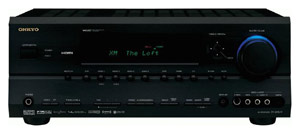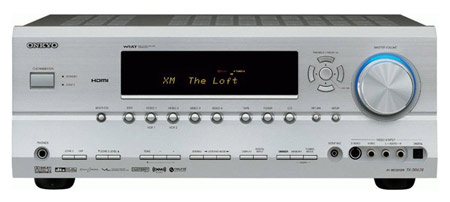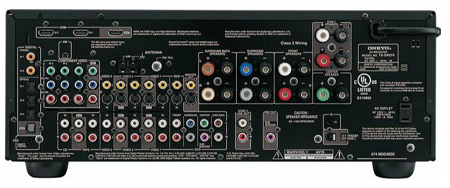Onkyo TX-SR674 HDMI-Switching Home Theater Receiver Review
By Chris Boylan
H.D.M.I... Like It!
Long-time readers will know that we've got a soft spot for Onkyo receivers. Our own video/film maven Joe Lozito uses an Onkyo receiver in his personal home theater system, and I myself have owned a couple of Onkyo receivers over the years (going back to my college days in the 1980s). When I heard about their 1080p-capable HDMI-switching
TX-SR674 home theater receiver, I was eager to get it into the BPBS labs for a closer look.
The Specs
The TX-SR674 offers 95 Watts/Channel for up to 7 channels (in a 7.1-channel configuration). This is more than enough power for a small to medium living room or home theater, assuming relatively efficient speakers. It sports 2 1080p-capable HDMI inputs (HDCP compliant, HDMI v. 1.1) as well as 3 high definition-capable component video inputs, plus the usual assortment of composite and S-video inputs. To simplify your connections, the unit will upconvert (and deinterlace) analog video inputs for digital output over HDMI. This means you'll only need a single thin HDMI cable between the receiver and your display device.

Onkyo's TX-SR674 HDMI-Switching Receiver.
On the audio side, the unit features 2 coax and 4 fiberoptic digital inputs, the 2 HDMI inputs already noted, plus a plethora of stereo analog inputs for non-digital sources. And in case you'd like to connect a Blu-Ray Disc or HD-DVD player to the unit via analog cables, the 674 has a set of those inputs too (7.1-channels). The unit also features Audyssey's 2EQ auto-calibration system (with microphone), which can simplify the set-up of your speakers.
The receiver is both XM-Ready and compatible with Onkyo's
DS-A2 ipod dock.
The Set Up
Connection of speakers and sources to the Onkyo receiver is a fairly straightforward process with the usual clear labels on the video and audio inputs. Onkyo even includes some cable label stickers in the box to help you keep your cables straight. The On-Screen menu is a bit rudimentary but functional. Simple text-based menu items allow you to step through the various set-up options including video input assignments, default surround modes and speaker configuration settings (should you choose to optimize your speaker settings manually).

The TX-SR674 is available in black or silver and features a front panel A/V input with analog and digital audio inputs.
Although the unit does offer two HDMI audio/video inputs (which support signals up to 1080p) and three HD-capable component video inputs, this does not mean you can hook up five high definition source components concurrently. The component video and HDMI inputs must be assigned to one of four specific named inputs on the receiver. This means you can only use a total of up to four high def video inputs at a time (e.g., 3 component plus 1 HDMI or 2 component plus 2 HDMI). This is still a fair number of high definition capable inputs for a low to medium-priced receiver and will be more than adequate for most users.

The TX-SR674 features high definition-capable HDMI and component video inputs.
But unlike the video assignment option in the set-up menu, I was a little surprised not to find an audio assignment option in these menus. The HDMI inputs automatically default to use the audio signal from the HDMI cable (which makes sense), but in order to assign a specific digital audio input with one of the component video inputs, you have to hit the "digital input" button on the front of the receiver. Once you have selected a specific digital input for a particular video input, the receiver remembers your choice and you should not have to select it again.
But where the Onkyo really shines in the set-up department is in the inclusion of Audyssey's 2EQ automatic speaker configuration option. Instead of having to manually tweak the speaker level, distance and crossover settings (by ear or with the use of an SPL meter), you simply plug in the attached microphone, place it at ear height in three different listening positions and click through a few prompts. The receiver generates its own test tones, the microphone detects levels and delays, and the Audyssey program optimizes the levels, speaker distance settings and crossover for your specific speakers in your specific room.
Compared to a manual calibration, the Audyssey settings were remarkably accurate. Of course, it has some limitations (it does not allow for a multiple subwoofer set-up, for example), but it will allow most people with most rooms and speaker systems to get surround settings that are much closer to the ideal than they would otherwise be able to get. Certainly compared to what many people do (plus in all the speakers and hope for the best), the Audyssey system will offer a vast improvement in surround sound levels, soundfield presetation and frequency blend.

the SR-674's remote is simple but functional.
Features/Ergonomics
In day to day operation, the TX-SR674 was very straightforward to use. The remote does not include backlighting (except the glowing "mode" buttons which tell you which device it's set to control), but it does offer direct input buttons and a logical button layout for commonly used functions and decide transport controls. It is a universal remote in that it can be programmed to operate multiple devices (TV, DVD, VCR, etc.), but it's not going to compete with high-end universal remotes such as the Logitech Harmony models. Speaking of Harmony remotes, the Onkyo receiver is available in Harmony's web-based database of devices and I had no trouble integrating the receiver with my Harmony 880 universal remote.
I used the receiver with various HDMI and component video-enabled devices including HDMI 1.3-enabled 1080p sources (Toshiba HD-XA2 HD-DVD player and Sony PlayStation 3 Blu-Ray disc player). The receiver had no trouble passing along the 1080p video signal to the display device and was able to decode multi-channel PCM, Dolby Digital and DTS signals that it received via HDMI. Of course, it could not natively decode the native Dolby TrueHD or DTS-HD Master audio lossless surround sound bitstreams (that would require HDMI 1.3 and built-in lossless format decoders) but neither did it break down or get confused when presented with these soundtracks. It simply decoded the "core" components of these surround sound tracks, treating them as if they were "legacy" Dolby Digital or DTS surround tracks.
In terms of getting the full benefits of Dolby TrueHD or DTS-HD Master Audio, the TX-SR674 can decode multi-channel L-PCM (Linear Pulse Code Modulation) surround sound tracks with no problems. So if your Blu-Ray or HD-DVD player supports conversion of Dolby True HD and/or DTS-HD Master Audio to PCM (most players do support at least one of these formats), then you will have no trouble reproducing the full surround soundtrack from compatible Blu-Ray or HD-DVD titles. I tested this with titles such as Poseidon on HD-DVD (Dolby TrueHD) and found the resulting sonic presentation to be stunning. Your other option to support these surround formats is to connect your player to the Onkyo receiver with multiple analog audio cables (5.1 or 7.1) but I find this sloppy and unnecessary given the quality of the L-PCM option.
I really liked the simplified connections of the 674. I connected a VCR, two DVD players, HD-DVD and Blu-Ray player to the receiver via various video cables (S-Video, component video and HDMI) and was able to get all these signals displayed on our reference Panasonic plasma display with just a single HDMI cable connected between the two components. This can really clean up cable clutter, turing a rat's nest of wires into a neat and tidy installation.
Also, I really appreciated the headphone output on the receiver. Seems simple but many high-end (and low-end) receivers and processors omit this handy little jack. With many a late night viewing/listening session, it was nice to have the headphone option. And unlike some other components I've used, the headphone output was active regardless of whether the source component was connected via analog or digital inputs. The Onyko happily converted and down-mixed multi-channel digital audio signals (connected via HDMI or Toslink) to stereo output over the headphone jack, and muted the speaker outputs when doing so.
The TX-SR674 features a powered second zone output so you can route any connected source, or the built-in tuner to a separate pair of spekers in another room or outside (stereo audio only).
Listening/Viewing Impressions
Compared to other comparably priced receivers as well as more expensive separate preamp/processors (with dedicated power amps) that we had on hand, the Onkyo held its own in terms of sound quality. It didn't quite have as much headroom or dynamic attack as our Outlaw multi-channel dedicated power amp, but nor did it suck up as much power or require as many cables as the separate systems did. In music and movie listening, the TX-SR674 did an excellent job driving efficient bookshelf speakers to suitable levels with no hint of strain or confusion. It even did a fair job driving notoriously picky Martin-Logan electrostatic speakers to reasonably high levels.
Stereo CDs sounded clean and harmonically balanced, with a believable (if not overly deep) soundstage in direct stereo mode, and benefited from a subtle but enveloping sense of ambience when played in Dolby ProLogic IIx mode. The receiver properly decoded rear-channel information (6.1/7.1) from DVD titles that were encoded in DTS-ES and DD-EX formats. The receiver also had no trouble decoding multi-channel L-PCM tracks from both Blu-Ray Discs (played back on a PS3) and HD-DVD discs (played back on Toshiba HD-XA1 and HD-XA2 HD-DVD players).
For the one DTS-HD Master Audio disc I threw at it ("Behind Enemy Lines" on Blu-Ray Disc), the receiver was not able to decode the full lossless DTS-HD track (as expected) but it gracefully decoded the core DTS soundtrack from this disc without skipping a beat.
Compared to more powerful dedicated power amps, there was some slight congestion and restriction of dynamics, particularly on dynamic orchestral works on CD or audiophile-quality DVD-Audio and SACD recordings, but only on the less efficient Martin-Logan speakers. When driving our NHT mini-monitors, the Onkyo receiver never seemed to lack for want of more power.
Considering how convenient the Onkyo unit is as an audio/video control center, I really wish it had a preamp output option (multi-channel line level output). If it had, I could have used it with more powerful external amps and would have had better luck driving the Martin-Logans. But driving $5,000+ worth of speakers with an $800 receiver is not a typical match. Considering the receiver is more likely to be paired with speakers from Polk, Infinity, Paradigm, Klipsch or the like, the TX-SR674 should be more than up to the challenge of driving them to acceptable levels (particularly in medium-sized home theater rooms and living rooms).
Final Thoughts
I enjoyed my time with the TX-SR674 receiver. The simplicity of its operation and the flexibility of its inputs and outputs (including HDMI upconversion of analog video sources) allowed me to easily connect multiple devices, as well as swap in and out new devices as they came through our labs for review. Sound quality on demanding material with inefficient high-end speakers was surprisingly acceptable, and was even better with more efficient speakers with which it's more likely to be mated. The Audyssey auto-calibration feature is extremely useful and will help even the technically-challenged to get the best performance out of their home theater system.
Its lack of HDMI version 1.3 support was not in any way a hindrance to us, even when connected to current generation HDMI 1.3-compliant 1080p source devices (Sony PS3 Blu-Ray Disc and Toshiba HD-XA2 HD/DVD). The only real advantages to HDMI 1.3 over HDMI 1.1 are "Deep Color" support (which requires support in both the source component and the display), and native bitstream support for Dolby True HD and DTS-HD Master Audio (which would require a more expensive built-in surround processor). And this is really not essential as long as your Blu-Ray Disc or HD-DVD player supports expansion of the lossless surround sound tracks to multi-channel L-PCM (which this receiver does support).
If you're looking to simplify your home theater and/or surround sound set-up, consolidating multiple audio/video sources to HDMI without the need for external video switchers, then the TX-SR674 is a worthy contender for your home theater dollars.
Where to Buy:
Detailed Specifications:- MSRP: $799
- Surround Modes: DTS NEO:6, DTS ES Matrix 6.1, DTS ES Discrete 6.1, DTS 96/24, DTS, Dolby Pro Logic IIx, Dolby Pro Logic II, Dolby Digital EX, Dolby Digital / AC-3
- Power Output (8 ohm, 20 Hz-20 kHz, FTC): 95 Watts/Channel (7 channels driven)
- Total Harmonic Distortion (THD): 0.08 %
- Damping Factor (1 kHz, 8 ohm): 60
- Input Sensitivity and Impedance: 200 mV/47 k-ohms
- PHONO Input: (none)
- CD and TAPE Play Output Level and Impedance: 200 mV/470 ohms
- TAPE REC/PRE OUT:
Frequency Response 10 Hz-100 kHz/+ 1 dB, - 3 dB (Direct mode)<,/LI> - S/N Ratio: 106 dB (Line in, IHF-A)
- Tone Controls: BASS +/- 10 dB, 50 Hz;
TREBLE +/- 10 dB, 20 kHz - Audio/Video Inputs: 2 HDMI, 3 Component Video, 5 composite video, 5 S-video, 2 coaxial digital audio (S/PDIF), 4 fiberoptic digital audio (S/PDIF), 6 analog stereo audio, 1 multi-channel analog audio input (7.1-channel)
- Audio/Video Outputs: 1 HDMI, 1 component video, 3 S-video, 3 composite video, 1 fiberoptic digital audio (S/PDIF), 1 subwoofer line level output, line level zone 2 output, 7-channel speaker level output, zone 2 speaker level output (stereo)
- Miscellaneous Inputs: RI (Remote Interactive) port, AM and FM antenna inputs, XM antenna input, 12V trigger output (zone 2), 120V AC power plug (switched).
Tuner Section:
- Usable Sensitivity: FM Mono: 15.2 dBf, 1 uV (75 ohms, IHF); FM Stereo: 22.2 dBf, 2 uV (75 ohms, IHF); AM: 300 uV/m
- Signal/Noise Ratio: FM Mono: 73 dB (IHF-A); FM Stereo: 67 dB (IHF-A); AM: 40 dB
- THD:
FM Mono: 0.3 %, 1 kHz; FM Stereo: 0.5 %, 1 kHz; AM: 0.7 % - FM Stereo Separation: 40 dB at 1 kHz
Physical Specifications:- Dimensions (W x H x D) 17-1/8 x 6-7/8 x 14-13/16 inches
- Weight: 25.1 lbs.
In the Box: - Onkyo TX-SR674 Receiver
- RC-651M Remote Control
- 2 "AA" batteries
- AM loop antenna
- FM wire antenna
- Speaker setup microphone with attached cable
- Plastic speaker terminal wrench
- Instruction Manual (English/French/Spanish)
- Remote control code chart
- Errata sheet
- Product Registration/Warranty Card
- Onkyo iPod dock information sheet
- XM Radio Connect & Play information
- Sheet of self-adhesive cable labels
- "Caution" sheet (re: speaker terminals)
Manufacturer's Contact Information:
Onkyo USA Corporation
18 Park Way
Upper Saddle River, New Jersey 07458
Tel: 201-785-2600
Fax: 201-785-2650
Web site:
www.onkyousa.com



